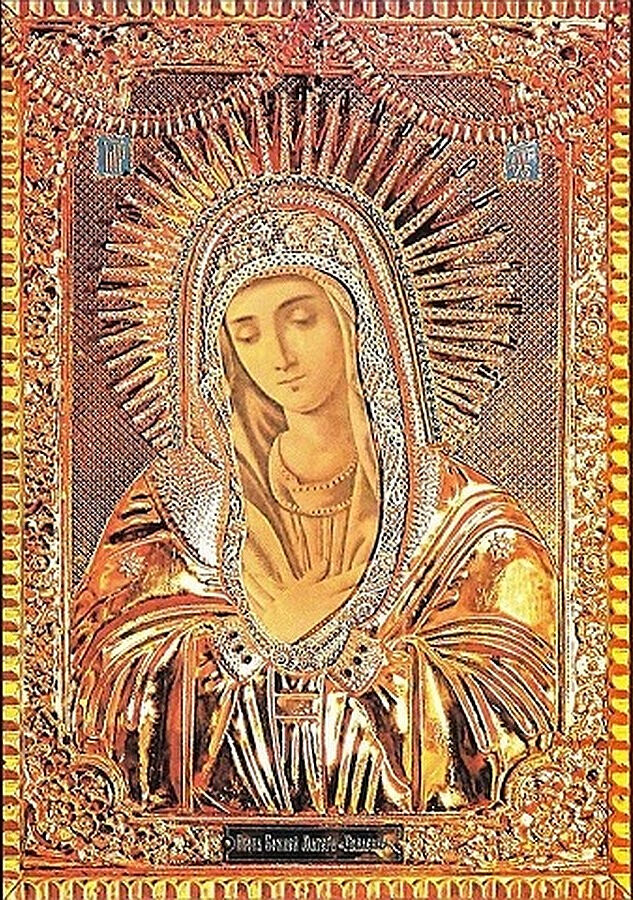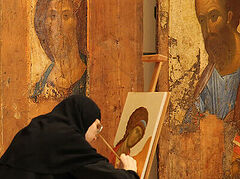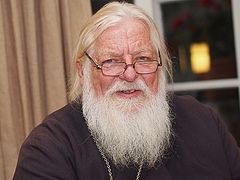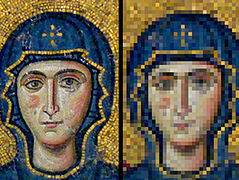This article is a continuation of a discussion by the author in response to opinions concerning the sacredness of holy icons in connections with their origin or style, published on Pravoslavie.ru, “Can Photo-Reproductions of Icons Be Considered Sacred in the Church?”
Iconographer V.S. Kutkovoy insists that only an icon painted by an icon painter is truly holy, whereas any of its photo-reproductions are only worthy of honor (τῖμή), but not of the veneration (τιμητική προσκὺνησις) determined by the seventh Ecumenical Council. And this means that they, in his own words, “are existentially not given full honor,” as the iconoclasts once suggested doing in relation to any images (i.e., honor without veneration).[1]
V.S. Kutkovoy writes that by insisting that an icon is a holy object, he does not call for “the sacralization of the material of the board and paints. <...> But the Church does not consider the action of the Holy Spirit through an icon to be a common occurrence. Therefore, for it (the Church) an icon is always holy[2]…” In doing so, he remarks:
“Why bring holy objects from Mount Athos to Russian churches today? In this case, would it not be enough to bring only their photographs? Why attach relics of the saints depicted on icons to them? Is it worth it to carefully preserve holy objects, including icons? The answers are obvious[3]…”
V.S. Kutkovoy refers to the authority of L.A. Uspensky, who spoke out “against the typographic and photographic production of holy icons[4].” L.A. Uspensky wrote:
“The line between the permissible and the impermissible in matter lies where matter loses its authenticity and character, starting to impersonate something other than what it is—that is, creating an illusion.”[5]
According to V.S. Kutkovoy, this means that a photo-reproduction of an icon “includes deception”, since “an illusion is a lie”, and this is unacceptable for a holy icon.
The author also cites an important quote from the article by the Uspenskys:
“A color photograph is a substitute for painting and genuine colors ... It is a deception.”[6] “And only in extreme cases, when it is absolutely impossible to have a real icon, did the Uspenskys consider it acceptable to use reproductions in prayer practice—this is better than praying without any icon altogether,” V.S. Kutkovoy sums up the position of the aforementioned theologians.[7]
Actually L.A. Uspensky went even further and declared only one artistic language acceptable in icon-painting, which communicates grace to icons. N.K. Gavryushin[8], criticizing this position in his essay, cites a remark of the icon painter and iconologist K. Shakhbazyan:
“Having identified the language of the icon with the way of depicting deified humanity, Uspensky had to seek an explanation for the fact that the same iconic language also depicts non-deified individuals... In fact, the difference can sometimes be made only by the presence or absence of a halo.”[9]
N.K. Gavryushin adds:[10]
“The immediate successor of L.A. Uspensky in his sphere, Professor Archpriest Nikolai Ozolin, without any doubt reproduces the point of view that defends the ‘only’ language of the ‘God-inspired icon-painting Tradition’, which allows one ‘to get to know visually and experimentally that the Prototype—the Divine face of the Incarnate Word—and His man-made icon have an imprinted unique name and a physical similarity, a hypostatic identity with all the ensuing grace-filled consequences.’”[11]
To this N.K. Gavryushin objects that the words quoted by Archpriest Nikolai Ozolin “do not correspond to the historical experience of the life of the Church, in which icons painted in a different iconographic manner, or even printed on plain paper, are venerated and recognized as grace-giving… The canonization of the only style that ensures the ‘grace’ of an icon threatens to degenerate the veneration of icons into iconolatry, the sacralization of ‘boards’ and gesso, which the iconoclasts feared not without reason, and which St. Maximus the Greek foresaw.”[12]
V.S. Kutkovoy in his article (probably referring to N.K. Gavryushin’s quoted remark) cites the “ecclesiological argument”:
“Such critics are simply obliged to cite as an example any ‘real experience’ of the veneration of paper icons: at least to list the feasts celebrated by the fullness of the Church in honor of typographic icons. We do not know such feasts yet.”[13]
That is why, he concludes, “With replication an icon becomes an ordinary illustration from an album of medieval paintings.” The prototypes in reproductions require only honor (τῖμή), “but not τiμητiκή πρoσκὺνησiς [veneration.—V.N.]…, which philosophically remains very problematic for postcards.”[14]
This means that, according to V.S. Kutkovoy, any photo-reproduction of a holy icon has a profane, not sacred, status in the Church. The theological refutation of this thesis was given in our previous article,[15] so here we will consider only the “ecclesiological” arguments.
Church experience
In the comments of readers to the article by V.S. Kutkovoy, published in 2014 in Russian on the Ruskline.ru website,[16] there was serious theological criticism of his views from readers. And to the quoted words about the absence of any feasts in honor of “paper icons” a reader replied wisely:
“We also do not have feasts in honor of wooden and porcelain, gold and silver icons. The author looked in the wrong direction and, therefore, saw the substance and materials, while the depicted Person should have been seen. Or should only the veneration of painted icons be recognized?”[17]
The same reader also gave concrete examples from Church life about miracles occurring from “photo-reproductions” of icons:
“Those who intrude into the limits of the action of Grace... intrude into the limits of the action of the Holy Spirit, with all the ensuing consequences. In 2003, I photographed three bleeding icons in the town of Klin near Moscow. The printed photo-reproductions began to stream myrrh and bleed in the same places as the prototypes—the photographed icons. In 2004, on the occasion of the arrival of a bleeding icon of the Savior from the Orenburg Diocese, lithographs (which had earlier been placed on the original) on offset paper were printed in a printing house. One of these reproductions bled, duplicating the original. In 2003, a wooden cross with a pasted image (silk-screening printing method) of the Crucifixion of Jesus Christ was purchased in a church shop. In 2004, the cross started streaming myrrh, and on the feast of the Procession of the Life-Giving Cross, blood began to flow from the places where the Lord Himself had wounds: from beneath the Crown of Thorns, from the rib and where His hands and feet were nailed. Of the three reproductions of icons from Klin one was chosen, and a photo-reproduction of the Orenburg icon and the Crucifixion were attached to it, and with the blessing of Bishop Justinian of Tiraspol [now Archbishop Justinian of Elista and Kalmykia.—Trans.], they were sent for research to the Main Forensic Center of the Ministry of Internal Affairs of Russia. The results show that it was real human blood with its rhesus, group, blood genotype and a complete DNA chain.”[18]
However, someone may argue that this is the testimony of an anonymous reader, which requires verification and confirmation. Besides, he says nothing about the veneration of photo-reproductions of icons.
But here is the testimony of a hierarch of the Russian Church, Met. Hilarion (Alfeyev) [now metropolitan of Budapest and Hungary.—Trans.], from his report at an international conference in 2005 (that is, almost at the same time):
“In recent years, one phenomenon has become widespread in Russia, to which many attach a special mystical meaning: myrrh-streaming from icons. Nowadays, icons stream myrrh everywhere—in monasteries, churches and private houses... Both ancient and modern icons stream myrrh; even reproductions of icons and postcards, which depict icons, stream myrrh.” Moreover, “myrrh streaming is an irrefutable, repeatedly recorded fact that cannot be questioned.”[19]
Thus, in his report read before a foreign audience, Vladyka Hilarion, with his archpastoral and scientific authority, confirmed the modern experience of the Russian Orthodox Church: Copies of holy icons [including postcards (!)] printed on paper stream myrrh in the same way that painted ones do. He interprets the phenomenon of myrrh streaming as “a manifestation of the mercy of God, sent for the consolation and spiritual strengthening of the faithful. Icons that exude myrrh are evidence of the real presence in the Church of those who are depicted on them: it testifies to the closeness of God, His Most Pure Mother and the saints to us.”[20]
It follows from what has been said that both on painted icons and on their reproductions, the image is really (to be more precise, mysteriously) connected with the prototype due to an external similarity and the unity of hypostasis regardless of the method of making icons (whether hand-painted or photograhically reproduced) and material (board, paper, cardboard, etc.). The One Who is “truly present in the Church” in a visible way through the myrrh-streaming from His image shows God’s mercy to those who believe in Him.
Vladyka notes that “not only canonical icons can be wonderworking, myrrh-streaming and revealed, but those painted in a ‘realistic’, or ‘academic’, style, along with images on religious subjects that are far from the canons of icon-painting.” At the same time, Vladyka Hilarion agrees with the position of L. Uspensky[21] in that the mentioned “phenomena in themselves do not turn painting into iconography. With regard to icon-painting, the Church has always put forward the criterion of canonicity, and not wonderworking, as the main criteria.”[22]
With regard to the artistic language (“the icon style”), this is true, but with respect to giving honor and veneration to icons, everything is different. Many of our churches (especially later ones) are decorated in the academic style of the eighteenth-nineteenth centuries (including the Cathedral of Christ the Savior in Moscow, St. Vladimir’s Cathedral in Kiev, etc.). Icons in these and other churches are also often painted in the same style, but due veneration is rendered to them: They are censed, candles are lit before them, they are kissed, prayer services and akathists are read in front of them. Moreover, some of the greatest saints of Russia prayed before such icons.
St. Seraphim of Sarov prayed in front of the “Tenderness” Icon (hence its other name—the “St. Seraphim—Diveyevo Tenderness” Icon), which is kept in the house church of the Patriarchal residence in Moscow. This famous icon was painted in the academic style, and not in the Russian or Greek styles of iconography. We deem it necessary to tell readers about its modern wonderworking photo-reproduction.
The Lokot “Tenderness” Icon of the Mother of God
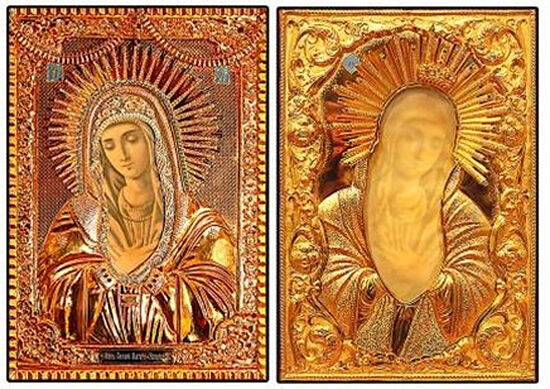 Lokot “Tenderness” Icon of the Mother of God. Left: a typographic print on paper; right: the wonderworking image on the reverse side. A frame was made on both sides of the icon.
Lokot “Tenderness” Icon of the Mother of God. Left: a typographic print on paper; right: the wonderworking image on the reverse side. A frame was made on both sides of the icon.
At the beginning of the coronavirus epidemic in March 2020, major Orthodox information resources reported that an unusual icon of the Mother of God would be brought to Moscow. The official website of the Moscow City Diocese wrote:
“On March 14, 2020, at 3:00 p.m., the wonderworking myrrh-streaming Lokot ‘Tenderness’ Icon of the Mother of God will be brought to the Church of Hieromartyr Hermogenes, Patriarch of Moscow and All Russia, in Golyanovo.... During its stay at the church in Golyanovo, access to it will be open daily from 8:00 a.m. till 8:00 p.m. Prayer services with an Akathist at the wonderworking icon will be served daily at 10:00 a.m., 2:00 p.m. and 6:30 p.m. The icon will be staying in the church until April 21.
“‘The Lokot “Tenderness” Icon of the Mother of God is the only icon in the world to stream myrrh on both sides. The icon appeared in a pious family in the village of Lokot of the Bryansk region. This is a former estate of Grand Duke Mikhail Romanov, the holy Tsar Nicholas II’s brother. On November 2, 1999, the icon started streaming myrrh,’ the rector of the Church of St. Hermogenes, Priest Alexei Dovgopoly, related.
“According to the priest, the mercy of the Mother of God through this icon is manifested in many miracles.
“‘On the reverse side of the icon a miraculous image of the Mother of God appeared, on which the image of the Savior as on the Shroud of Turin is also visible. The icon abundantly streams myrrh with various fragrances, and has also bled and wept several times,’ Fr. Alexei noted. ‘After praying in front of this icon, many receive healing and grace-filled help, and find those who were reported missing. We are happy to invite Muscovites and guests of the capital for joint prayers and veneration of this wonderworking icon’.”[23]
On the Sedmitza.ru website a similar announcement was accompanied by a clarification: “With the blessing of His Holiness Patriarch Kirill”,[24] which is natural (the Patriarch is the ruling hierarch of Moscow) and important for us, since it indicates the approval of the abovementioned actions with this icon by the Primate of the Russian Church.
Y. I. Shishkov, who has been accompanying the icon on its journeys for years, said in an interview with a Samara journalist:
“It was not easy to get to Moscow with the relic. I had to receive the blessing of several archpastors, including Bishop Thomas (Mosolov) of Pavlovsky Posad [now Bishop of Odintsovo and Krasnogorsk, Head of the Moscow Patriarchate’s Administrative Secretariat.—Trans.], who is well-known to Samara residents. All of them gave their blessing, but the last word was left to His Holiness Patriarch Kirill. He personally blessed us to take the Lokot Icon to Moscow. And we arrived in Moscow right on the day when the outbreak of the epidemic was announced.”[25]
Remarkably, the authors of the announcement on the website of the Moscow City Diocese for some reason omitted an important detail: The described wonderworking icon is nothing more than a reproduction on paper of the “St. Seraphim—Diveyevo Tenderness” Icon. That is, this is the same kind of “photo-reproduction”, denigrated by V.S. Kutkovoy other like-minded people; not even an ancient Russian-or Byzantine-style icon, but one in the academic style. Moreover, an image of the Mother of God with the face of the Savior (turned upside-down in Her womb), which, of course, can be found neither on the front side nor on the original, has been reflected on the reverse side of this reproduction. Now both sides of the paper icon are in frames (see photos).
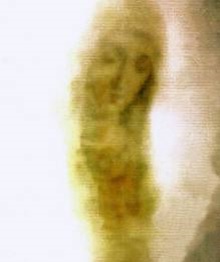 The image of the Mother of God, not made by hands, on the reverse side of the Lokot Icon, printed on paper. In the lower part you can see a human face turned upside down in relation to the Mother of God, similar to that of the Savior on the Shroud of Turin.
The image of the Mother of God, not made by hands, on the reverse side of the Lokot Icon, printed on paper. In the lower part you can see a human face turned upside down in relation to the Mother of God, similar to that of the Savior on the Shroud of Turin.
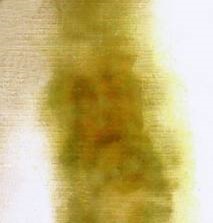 The face of the Savior, not made by hands, from the Lokot “Tenderness” Icon
The face of the Savior, not made by hands, from the Lokot “Tenderness” Icon
Christ’s face from the Shroud of Turin probably miraculously appeared on a reproduction to better convince the skeptics who neglect printed icons. According to the canons of the seventh Ecumenical Council, images of Christ “originate from the image, not made by hands, created by Jesus Himself and sent by Him to Abgar, ruler of Edessa (Mansi XII, 693).”[26]And most experts believe that the cloth with this image is the Shroud of Turin.
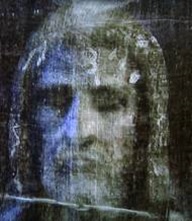 A 3D reconstruction of the face on the Shroud of Turin
A 3D reconstruction of the face on the Shroud of Turin
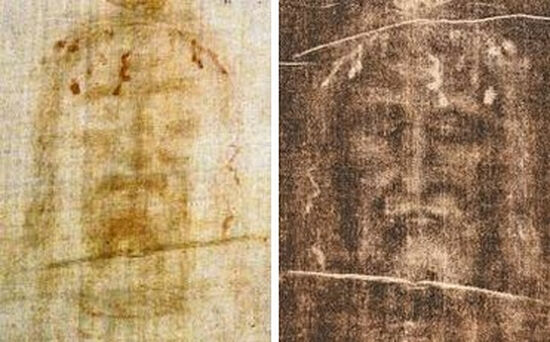 The Savior’s face on the Shroud of Turin, positive and negative.
The Savior’s face on the Shroud of Turin, positive and negative.

